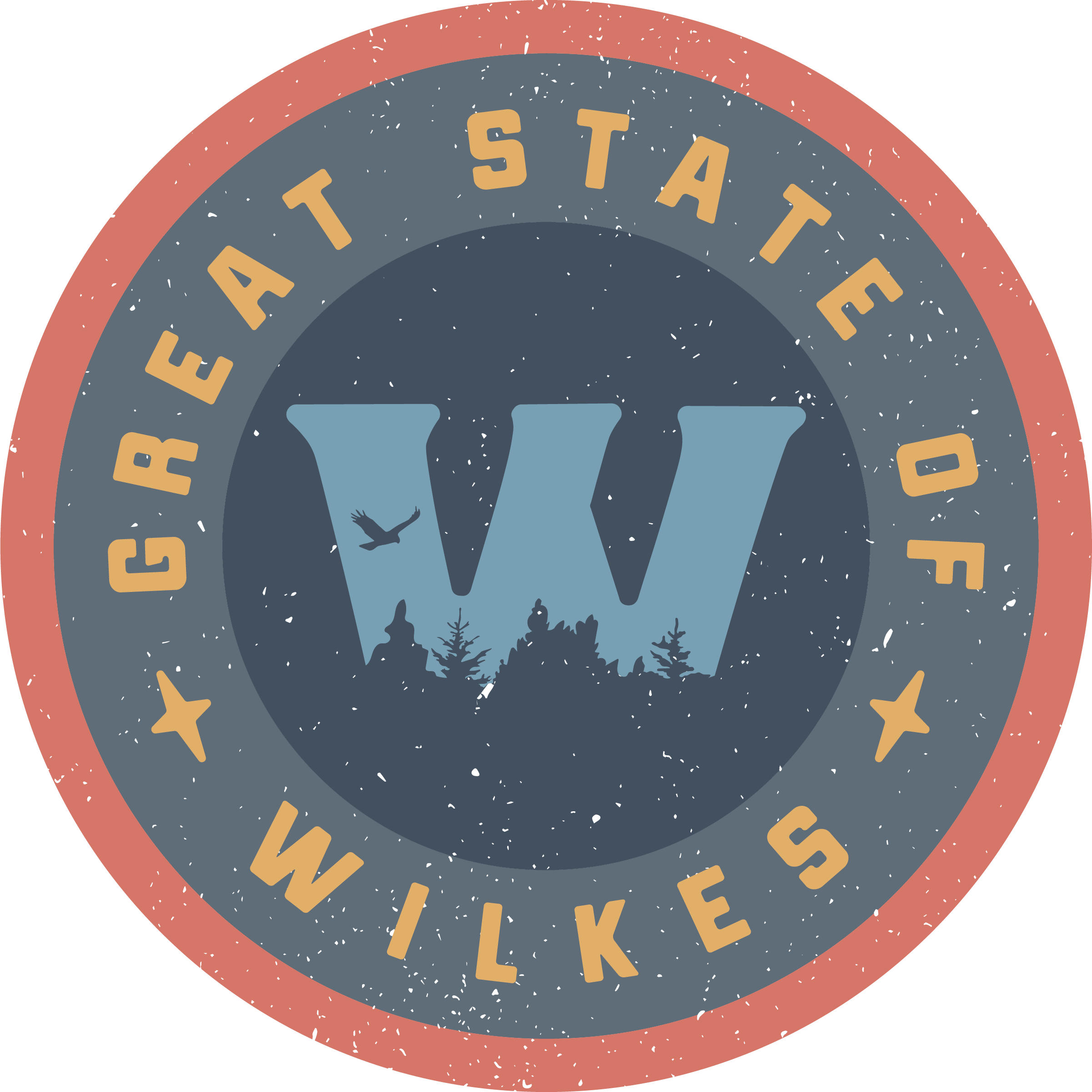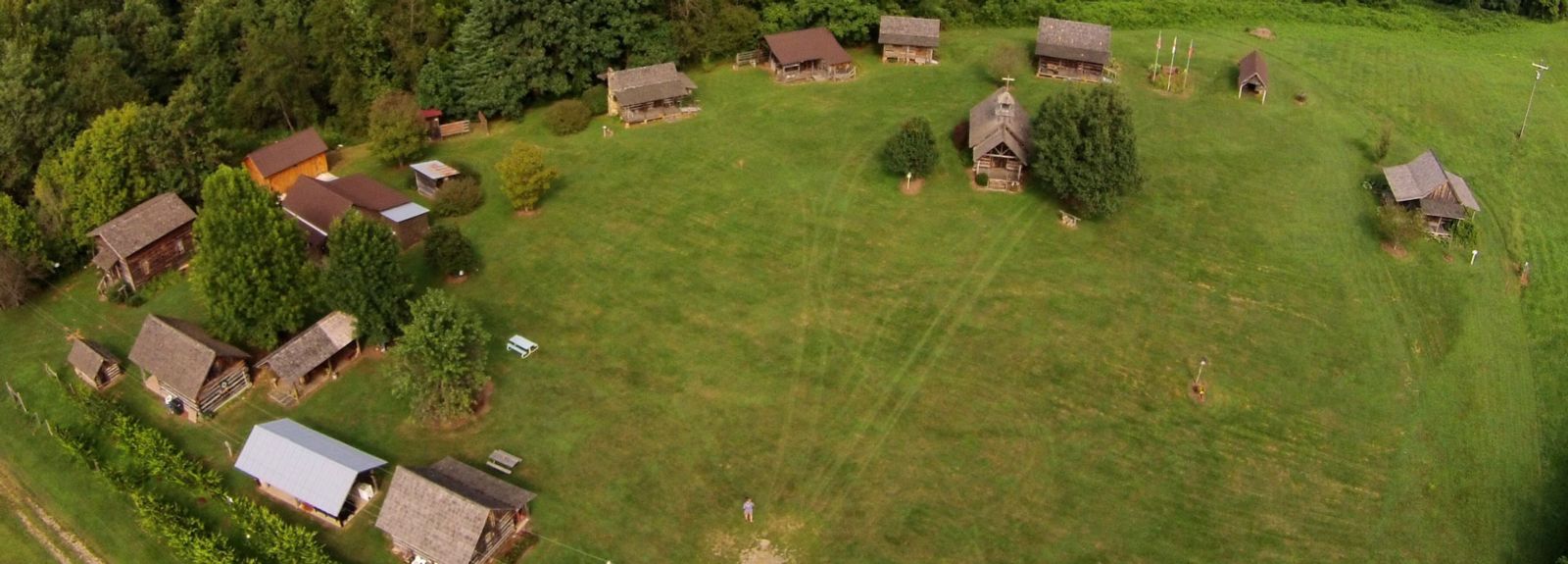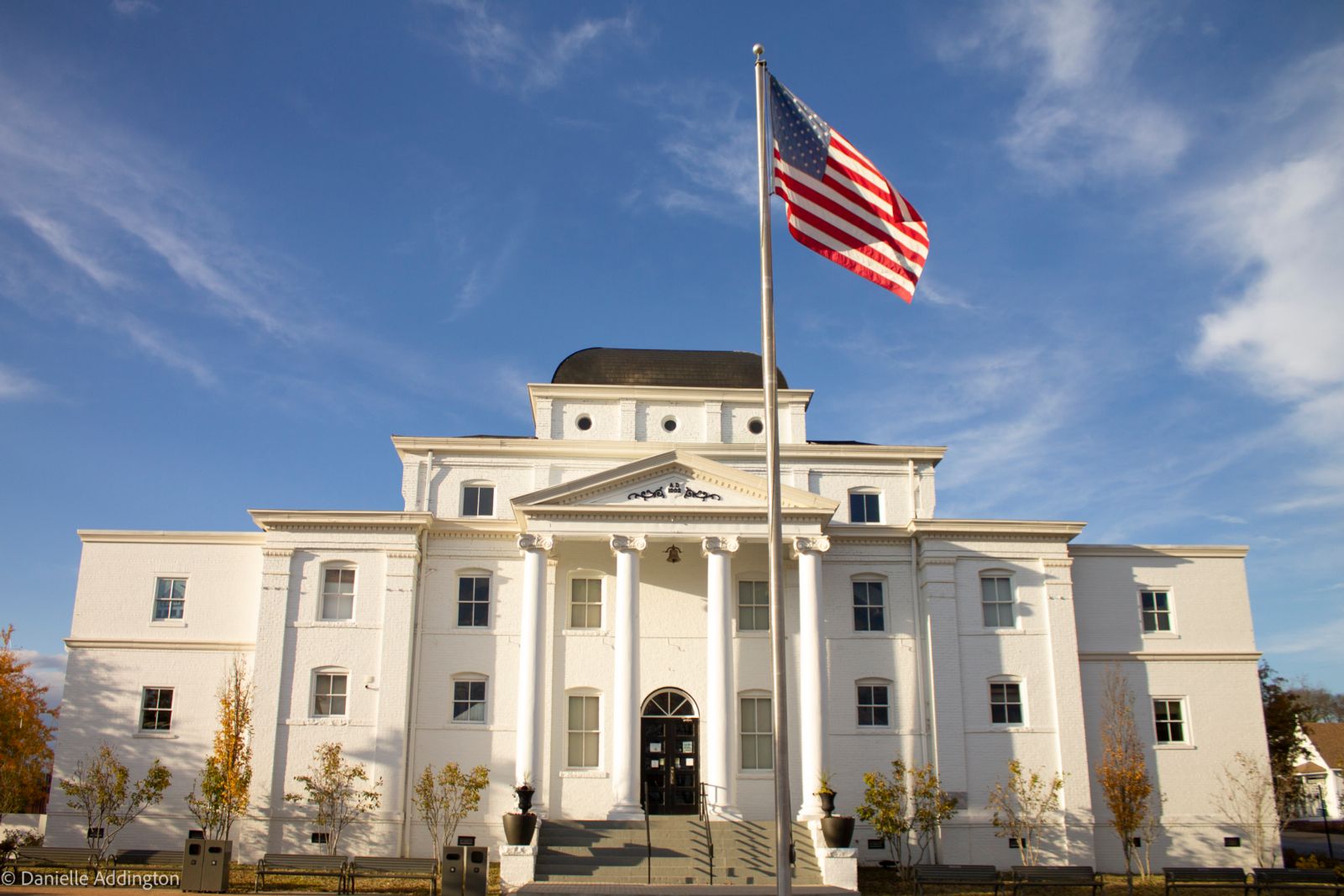
Time Travel Through Wilkes County, North Carolina
It’s a crisp fall morning in the mountains outside of Wilkesboro, North Carolina. The rushing rivers, verdant valleys, and wooded foothills suggest the Scottish Highlands, making it an ideal setting for the annual Outlander Festival. As would-be “Jamies” and “Claires” gather around a campfire, young women chat with reenactors selling colonial crafts. Admiring a handstitched dress fashioned in 18th century style, a 20-something sighs, “Oh, to go back in time . . .”
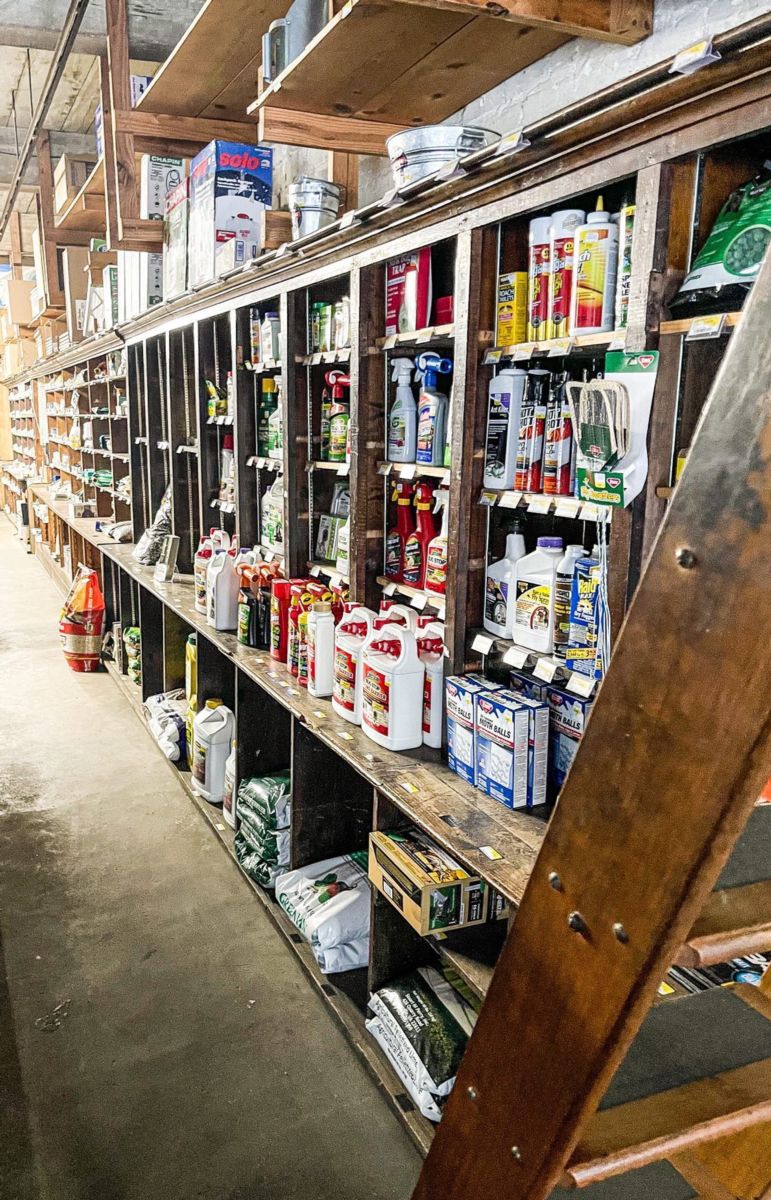 She’s come to the right place for time travel. Exploring the hills, hollers, and back roads of Wilkes County, North Carolina, you see century-old barns sheltering livestock and hay. A farm implement rusting into the earth isn’t someone’s idea of farmhouse décor; it belonged to her grandfather, and she hasn’t the heart to throw it out. Over at Wilkes County Hardware , locals congregate around a wood-burning stove to discuss events of the day or the decade. No matter how compelling the conversation, someone greets you with a friendly, “If you need help, just holler!”
She’s come to the right place for time travel. Exploring the hills, hollers, and back roads of Wilkes County, North Carolina, you see century-old barns sheltering livestock and hay. A farm implement rusting into the earth isn’t someone’s idea of farmhouse décor; it belonged to her grandfather, and she hasn’t the heart to throw it out. Over at Wilkes County Hardware , locals congregate around a wood-burning stove to discuss events of the day or the decade. No matter how compelling the conversation, someone greets you with a friendly, “If you need help, just holler!”
There’s a quiet pride among locals who can trace their roots back seven or more generations. Take John Freas. He hand-built a log home on land that has been in his family since 1820. His wife Mary spends hours turning out traditional weavings at a loom once used by Lucy Morgan, John’s aunt and founder of the Penland School of Craft. Brian Call brews whiskey using an 18th century family recipe and buys corn from the same mill his grandfather patronized.
The history of Wilkes County mirrors that of America . . . its stories tell of exploration, the quest for religious and political freedom, battles won and lost, the building of business empires.
Tracing the Timeline of Wilkes History
Even if you come here for the mountain biking, camping, wine tastings, or music festivals, don’t miss the Wilkes Heritage Museum in downtown Wilkesboro. The centerpiece of Heritage Square, every exhibit housed in this grand 1902 courthouse weaves the story of Wilkes – from prehistoric to contemporary times. The second-floor Blue Ridge Music Hall of Fame showcases the region’s musical heritage and hosts an annual event honoring national and regional musicians.
“People don’t expect a small-town museum to be this extensive. They arrive thinking they’ll spend 30 minutes and end up staying several hours or returning a second day,” says Director Jennifer Furr.
Known as the “mini Smithsonian,” the 20,000-square-foot museum houses 17 rooms covering everything from Native American and African American history to antique medical instruments and military displays to moonshine stills and vintage race cars. “People see themselves reflected in the diverse exhibits. There’s something for everyone,” Furr says.
The museum property also includes the Old Wilkes Jail (1859) and the Captain Robert Cleveland log home (1779). The museum tour is self-guided; guided tours of the jail and Cleveland home run Monday-Saturday, 11 a.m., 1 p.m., and 3 p.m. (Allow an extra hour to tour the jail and Cleveland home.)
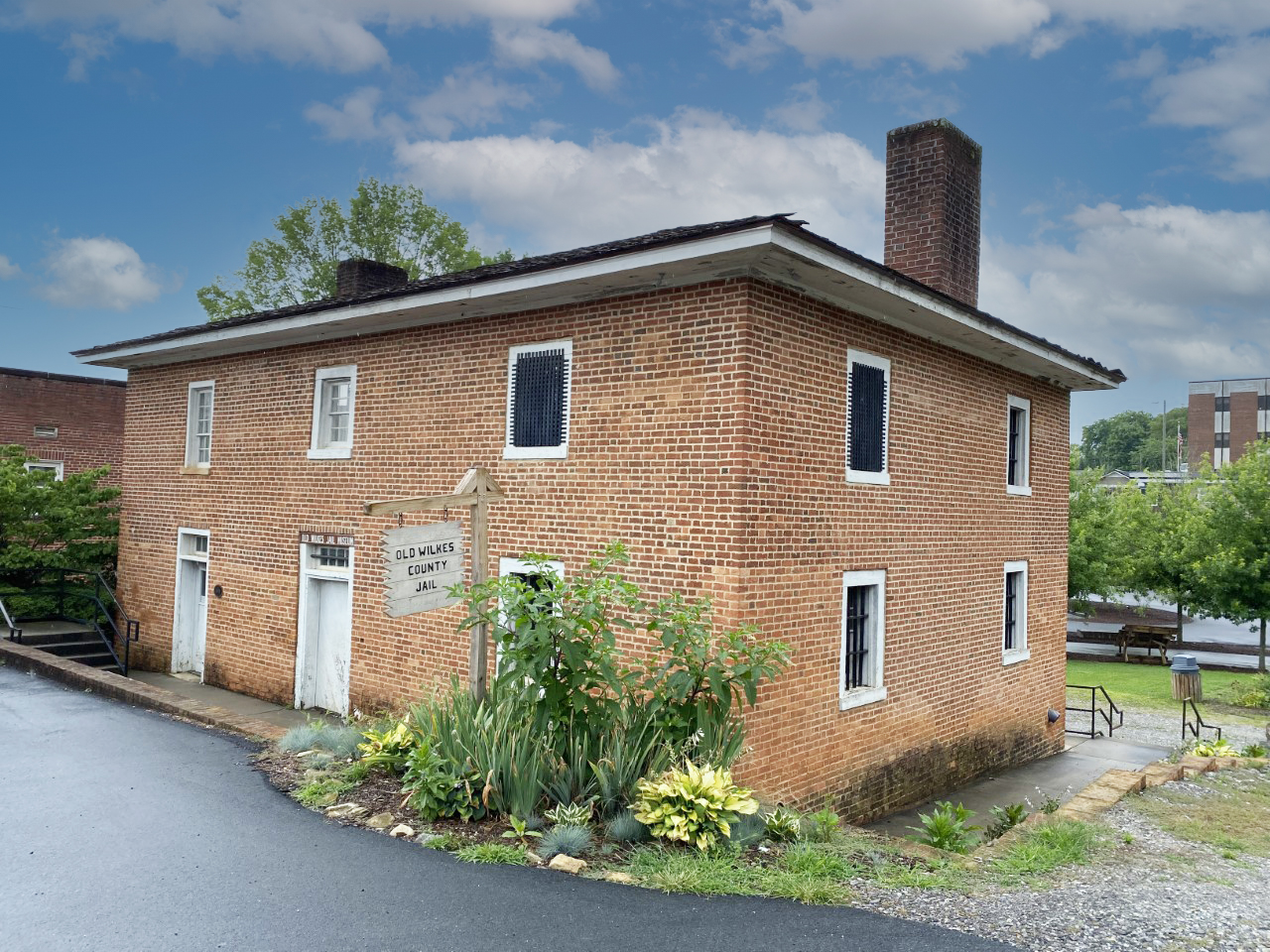 The jail’s most infamous inmate, Tom Dula, cooled his heels here for three months before being transferred to the Iredell County Jail. Captain Cleveland’s cabin was moved to its current site from Purlear, North Carolina. Though rough-hewn, the two-story structure with its original stone fireplace was luxurious compared to other frontier cabins. Cleveland needed every inch of that space, considering his 15 children.
The jail’s most infamous inmate, Tom Dula, cooled his heels here for three months before being transferred to the Iredell County Jail. Captain Cleveland’s cabin was moved to its current site from Purlear, North Carolina. Though rough-hewn, the two-story structure with its original stone fireplace was luxurious compared to other frontier cabins. Cleveland needed every inch of that space, considering his 15 children.
After exploring the Cleveland home and jail, check out 11 other historic buildings on the Wilkesboro Architecture Walking Tour. Spanning the 1830s to 1915, they reflect the character of Wilkesboro as it evolved. All are within walking distance of each other and all but three are open to the public. For walking tour information, call 336-818-9294.
If walking whets your appetite, grab a bite at Dooley’s Grill & Tavern. Named for the county’s most notorious celebrity, it’s housed in the former Smithey Hotel east of the Wilkes Heritage Museum. The exterior looks much the same today as it did in the late 19th century.
Early Origins
Compared to Native Americans, Captain Cleveland and other white settlers were late comers. Indigenous people lived here as far back as 10,000 to 12,000 years ago. Of North Carolina’s three dominant tribes, the Cherokee, Catawba, and Tuscarora, the Cherokee were the most prominent locally. They lived in large villages where North Wilkesboro stands today, and near the Yadkin and Reddies Rivers. Like their legendary counterparts in Massachusetts, they taught European settlers how to grow corn.
To see vestiges of this ancient civilization, including arrowheads, cooking implements, projectile points, carvings, and pottery, visit the Heritage Museum and Whippoorwill Academy and Village in nearby Ferguson.
Even before Native Americans battled European settlers encroaching on their land, they held intertribal skirmishes along the Yadkin River. In 1902, John Crouch recorded a history of Wilkes County called New River Notes. He wrote that whenever Yadkin River land was cleared for farming or building, large numbers of Native American skeletons, tomahawks, and arrow flints were unearthed.
Pioneer Days
Early pioneers, mostly Scotch-Irish and some European, were attracted by plentiful game, timber, fertile soil, and the rivers. One suspects Celtic settlers had another reason for settling here: the rocky hillsides, green valleys, and rushing rivers reminded them of home.
Most pioneers lived in rustic backcountry cabins and worked the land along with their families. Besides subsistence farming, early homesteaders supplemented their finances and diets by trapping and hunting. Eventually, a timber and sawmill trade evolved, followed by the textile industry in the 1820s.
Living in remote, isolated areas forced frontiersmen to become self-reliant and wary of anyone who threatened their hard-won independence. When the need arose, however, they could be called upon to help their fellow settlers harvest crops, butcher hogs, and raise a barn. Frontier life left little time for leisure, but when the occasion arose, pioneers tuned up their fiddles and other instruments common to the British Isles.
Wilkes County was formed in 1777 by a North Carolina legislative body called the General Assembly. The county wasn’t officially established until 1778. Pioneers had been living here long before the government made it official. The first intrepid explorer to come here is thought to be Christopher Gist, a surveyor and Indian agent who arrived in the 1740s. Throughout his career as a frontiersman, Gist made significant progress with western expansion. He worked closely with George Washington, even saving his life twice.
The county was named for John Wilkes, a controversial English politician who sided with the colonists in their fight for independence. Some pioneers saw Wilkes as a martyr for liberty – his radical views cost him his seat in Parliament.
The county lines today look nothing like the original boundaries that stretched as far as Virginia and the Smoky Mountains. New counties were gradually created from the original landmass, but Wilkesboro remained the county seat. No matter the distance or difficulty, Wilkesboro was where you paid your taxes, bought or sold land, went to court, and carried out other business.
A Famous Frontiersman
Christopher Gist may be considered the first settler, but he’s not the most famous. Daniel Boone lived near the Yadkin River around the 1740s and married North Carolinian Rebecca Bryan. The Bryan name is still prominent in Wilkes County today.
“It’s believed that Daniel Boone lived in Wilkes County longer than any other location and had three homesites here,” says Margaret Martine. She serves as a “keeper of local history” and director/owner of Whippoorwill Academy. A self-described “collector of old houses,” one of her most precious possessions is Boone’s hunting cabin.
Whippoorwill Academy sits on 50+ acres owned by Martine’s Ferguson ancestors since the 1700s. The bucolic setting and collection of rustic cabins lends itself to time travel. The old Ferguson homeplace, built in the 1870s, sits in stately contrast to the cabins. It was home to Captain Lindsay Ferguson, Martine’s grandfather.
The site is open to the public the third Saturday of each month and hosts events throughout the year, including the Daniel Boone Festival and Tom Dula Day, (held alternate years), James Larkin Pearson Poetry Competition, and the Real Scots Wear Plaid Day. Depending on the event, you might enjoy hearth cooking and blacksmithing demonstrations, live music, Appalachian clogging dances, poetry readings, or art and crafts exhibits.
Spiritual Traditions
The Moravians, a group of Christian religious followers originally from Central Europe, left their mark even though they didn’t stay here long. In the 18th century, they explored this area as a possible home. Supposedly, they saw so many Cherokee campfires along the Yadkin River, they moved on and settled in what’s now known as Winston-Salem. Their influence is still felt in the Moravian Falls community. Many people believe that the Moravian tradition of 24/7 prayer instills the land around the waterfall with healing properties. Some even claim to have “angel visions” while visiting the area.
Religion played a strong role in Wilkes then and now. In a county of more than 300 churches, St. Paul’s Episcopal Church was the first building in Wilkesboro to be consecrated for religious purposes. Its Gothic architecture and churchyard appear plucked straight out of England. The church traces its origins back to an 1836 baptism performed by the bishop of North Carolina; construction of the original chapel did not begin until 1848. The building was consecrated in 1849; it’s said that some people walked more than 50 miles over mountainous terrain to witness the event. The first parishioners worshiped by candlelight without benefit of indoor plumbing. Today, a common area connects the old chapel with a newer section built when a 1928 storm destroyed a chapel wall.
Situated on its peaceful perch overlooking downtown Wilkesboro, St. Paul’s is well worth a visit. Inside the church, artist Ben Long created frescoes using techniques inspired by Michelangelo. The frescoes interpret two moments in the life of St. Paul. “He was one of the first writers to document Jesus’ life. The frescoes depict his Road to Damascus experience, also known as Paul’s conversion, and his writing of the epistles,” says Docent Bill Hurd.
On church tours Hurd also points out the “rich symbolism” of the chapel’s stained-glass windows. Escorting visitors outdoors, he leads them to a labyrinth patterned after one in France’s Chartres Cathedral. “It’s open to the public for contemplation and meditation.”
Take a self-guided tour of the church and frescoes Monday-Friday, 8-4. To schedule a docent-led tour, call 336-667-4231.
The Making of a Nation
Although the South is inextricably linked with the Civil War, “The people of Wilkes County participated in a major turning point in the American Revolution,” says Jennifer Furr.
When the British couldn’t subdue the northern colonies, they moved South, taking control of Savannah in 1778 and Charleston in 1780. Setting their sights on North Carolina, they were helped by Major Patrick Ferguson (a distant relative of Margaret Martine) who recruited British loyalists to subdue Scotch-Irish patriot pioneers. The plan worked, briefly. Considering his own Scotch heritage, Ferguson should have known his people rarely back down from a challenge. When he commanded the patriots to stop rebelling or his army would “hang their leaders and lay their country waste with fire and sword,” it only riled the fiercely independent mountaineers.
A patriot militia formed, drawing 2,000 men from several Appalachian states including North Carolina. A large contingent came from Wilkes County, as did military leader Colonel Benjamin Cleveland, Captain Robert Cleveland’s brother.
The patriot militia, or the “overmountain men,” rode horseback over mountain ridges, some nearly 5,000 feet high. Pressing on despite treacherous terrain and bad weather, they eventually defeated the British at the Battle of Kings Mountain in nearby South Carolina in October 1780. As John Crouch writes, “This was the turning point of the fortunes of America. This decisive blow prostrated the British power for the time, vanquished the Tory influence, and encouraged the hopes of the patriots.”
The Overmountain Victory National Historic Trail traces their difficult journey. More than 20 miles of the Trail pass through Wilkes County; seven miles are located along the Yadkin River Greenway. As you walk or bike along the Greenway, pause at Smoot Park Trail. Enjoying this serene scene today, it’s hard to imagine the sacrifices made by an army of hardscrabble frontiersmen to ensure our freedom. Another portion of the trail is located along picturesque W. Kerr Scott Dam and Reservoir.
Remember Captain Cleveland’s log home in Wilkesboro? When he wasn’t farming, Captain Cleveland led the local militia and fought alongside his brother at the Battle of King’s Mountain. Historians say that victory was Colonel Cleveland’s greatest achievement. “Rumor has it that (Colonel) Cleveland came back from Kings Mountain with a great war prize – Major Patrick Ferguson’s horse. We have a print of that event on display in the museum,” Furr says. A statue of Colonel Cleveland stands near his brother’s log home.
In New River Notes, John Crouch writes, “Colonel Cleveland . . . exerted a commanding influence among the frontier people . . . his patriotic activity did much to preserve the western portion of North Carolina from British and Tory ascendency.”
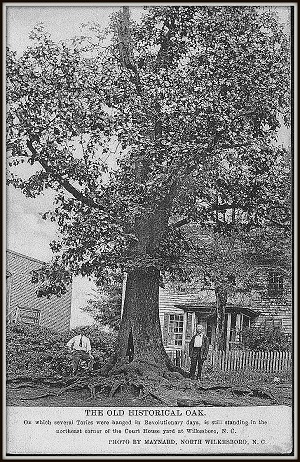
The Tory Oak
On the north side of Wilkes Heritage Museum, a sign commemorates the spot where an oak tree once played a dark role. During the Revolutionary War, at least five Tories (British loyalists) were court martialed and sentenced to hang from that tree. Colonel Cleveland oversaw the execution with help from his men. According to local legend, two Tories were horse thieves hung from the same clothesline they used as halters to lead the stolen horses away.
Enslaved people
Slavery wasn’t as common in western North Carolina as it was elsewhere in the state and South. The rugged terrain and rough roads made it impractical to transport crops, so most farms remained small and subsistence level.
However, like the rest of the South, Wilkes County has a complicated history with African Americans. Slavery did exist, with several prominent landowners, including Colonel Cleveland, using slaves to work their larger farms. Enslaved people helped build St. Paul’s Episcopal Church in 1848, and yet four were confirmed at the church and others are buried in the churchyard. When a Traphill landowner refused to allow his slaves to be buried in his family cemetery, his neighbors, the Union sympathizer Bryans, allowed the burials in their family plot.
Both freedmen and enslaved individuals lived in Wilkes County; most lived in a Wilkesboro neighborhood known as Cairo. By the mid-1980s, Cairo had about 1,200 residents, two schools, nine churches, and 25 businesses. One of its most important community fixtures helped further the lives and livelihoods of Black children.
Wilkes Heritage Museum Director Jennifer Furr says visitors are surprised to learn about the county’s Lincoln Heights Rosenwald School. Built in the early 1920s, the schools were funded by Julius Rosenwald, a philanthropist and president of Sears, Roebuck and Company, as well as Booker T. Washington, and local fundraisers. Rosenwald schools provided educational opportunities for Black children living in the rural South. Lincoln Heights students were bused in from rural communities in Wilkes, Ashe, Watauga, and Surry Counties. In the early 1920s, Lincoln Heights was the only high school in northwestern North Carolina where African-Americans could earn a high school diploma. Currently used as a community center, the school building still stands, just down the road from Wilkes Heritage Museum.
During the Civil Rights era in the 1960s, Wilkes had its share of turmoil. Local Black people demanded an end to Jim Crow laws in Wilkes County. There were demonstrations, lunch counter sit-ins, and an attempt to integrate the public pool. Change was slow, but inevitable, as courageous locals stood their ground against discrimination and racism.
The Wilkes Heritage Museum’s African Americans History Room gives visitors a deeper appreciation of Black history. Peering into the weathered faces of enslaved people in photographs, it is impossible to imagine what they endured. Then again, the story and photographs of Lady Sara Lou Harris Carter will lift your heart. Though married to the ambassador to British Guyana who was knighted by Queen Elizabeth II, Lady Carter achieved her own milestones. Despite her humble roots, she became highly educated and achieved success as an entertainer, model, and humanitarian. A stunning beauty, she broke the color barrier in the late 1940s as the first African American model in the New York buyers fashion show, and was among the original 12 models working with the Branford Modeling Agency, the first licensed African American modeling agency in the U.S.
Civil War Raids
If General Sherman was intent on destroying Georgia on his March to the Sea, Major General George Stoneman had similar intentions for North Carolina. Stoneman’s Raid, the county’s best known Civil War event, happened in the spring of 1865. To prevent General Robert E. Lee from eluding Federal troops, Stoneman’s 6,000-strong army destroyed railroads, depots, warehouses, and ammunition plants. Local civilians suffered as the army plundered its way through the county. Many hid their horses and valuables in the forests and mountains and didn’t venture out for several days after the Raid.
Things could have been worse. Historians think Stoneman was not as destructive due to the large number of Union sympathizers living in Wilkes. Captain John Q. A. Bryan of Traphill recruited about 1,000 men for the Union. It was a risky business, but Bryan was so good at evading the Home Guard and Confederate spies sent to capture him, he was nicknamed the “Old Red Fox”.
Calvin Cowles also emerged a local hero. Cowles stepped in as Stoneman’s soldiers prepared to burn provisions the Confederates had collected. He told them the provisions should be distributed among the local families of Union men. Cowles saved the storehouse and risked his life further to save the courthouse and jail.
Once again, the Wilkes Heritage Museum leaves no stone unturned. You’ll find Civil War artifacts, uniforms, and documents. As you drive around the county, look for historic markers spotlighting local Confederate leaders such as Brigadier General James B. Gordon who served under J.E.B. Stuart, and William H.H. Cowles, a lieutenant colonel who survived the war and practiced law in Wilkesboro.
At Whippoorwill Academy, you can see Captain Lindsay Ferguson’s 1870 homeplace, and even spend the night there in an Airbnb. “Captain Ferguson, my great grandfather, was a Confederate who led the Home Guard to keep the peace. His brother Jesse served with Robert E. Lee when he surrendered at Appomattox. Ragged and weary, Jesse walked home to Wilkes County and later became the sheriff. One of the buildings in downtown Wilkesboro still bears his name,” says Margaret Martine.
A Miracle Times Two
Just when you think you’ve learned all there is to know about Wilkes County, another surprise awaits. In 1839, the world’s most unique brothers arrived in town. Chang and Eng Bunker were born in 1811 in Siam (what’s now known as Thailand.) At the time, they were the first conjoined or “Siamese” twins most people had seen. While their situation was a major disability in the 19th century, the clever brothers turned it into an opportunity.
At age 18, they signed a contract with Captain Abel Coffin who charged curious audiences to see the twins. After touring the U.S. and Europe for three years, the business relationship soured. The brothers weren’t defeated. They learned to speak English and educated themselves. After parting ways with Coffin, they toured on their own throughout the U.S. and Canada. Their act included lectures, acrobatics, and displays of physical strength.
Along the way, they befriended Dr. James Callaway who invited them to visit him in Wilkes County. The Bunker brothers were so impressed, they purchased land and moved to Traphill in 1839. Touring made the twins prosperous. They built homes, became slaveholders, and established plantations. They also became American citizens, which required a surname. The twins chose Bunker, the name of an American friend.
Chang and Eng lived to be more than sixty years old. They married two (non-twin) sisters and fathered 21 children between them. Their lives are chronicled in a Wilkes Heritage Museum exhibit.
The Scandal Wilkes Never Forgot
Every time Margaret Martine reaches for a cup of sugar, she touches a portal leading to one of Wilke’s most notorious characters. “My pantry door was salvaged from Tom Dula’s cabin. My great grandfather bought the property. At some point, he wanted the land for pasture and the cabin had to go. My grandmother asked for the door and stored it in her barn until I came along,” Martine says.
Thomas C. Dula (locally pronounced “Dooley”) was born in 1845 in Wilkes County to a poor mountain family. He died by the noose in 1868, but his legend far outlived his short tempestuous life.
Besides playing the fiddle and serving as a Confederate soldier who became a prisoner of war in Maryland, Dula was known as a ladies’ man. His conquests include Ann Foster (married name Melton), possibly her cousin Pauline, and their cousin Laura Foster, the girl who would spell his doom.
Early one May morning in 1866, Laura Foster rode away from home on her father’s horse. Passing a friend on the road, she explained that she and Dula were about to elope. (Laura was supposedly pregnant at the time.) The next morning, the horse returned to the Foster homestead without its rider. A search ensued. In June, searchers found the young woman in a shallow grave, dead from a knife wound.
Did Dula, who allegedly threatened to kill Laura Foster because she gave him syphilis (though a local doctor had first treated Pauline Foster for the disease), do the deed? Or was it Dula’s jealous lover, fiery Ann Melton – the third party in this historic love triangle?
Authorities didn’t take any chances. They held Dula and Melton in the Wilkes Jail and sent both to trial. Dula maintained his innocence, but it didn’t help his case that authorities had to track him down in Tennessee after Foster’s murder. His lawyer, former North Carolina governor Zebulon Vance, moved the trial to Iredell County, hoping the sordid publicity wouldn’t spread that far. It didn’t work. Dula was sentenced to hang. Vance appealed, but a second trial sealed the young man’s fate.
Facing the inevitable, he confessed to the murder, a confession some believe he made to save Melton from the gallows. She was released, but some still think she murdered Foster and buried her body with Dula’s help.
Tom Dula was hanged in Statesville, North Carolina, in May 1868, two years after a love-struck Laura Foster rode off to her death.
The incident became what Jennifer Furr calls the “nation’s first highly publicized crime of passion.” It’s the scandal Wilkes never forgot, one that has launched poems, movies, and the “Tom Dooley” folk song. The Southern Appalachians have never lacked for storytellers and musicians. Some people credit local poet Thomas Charles Land with penning the home-grown “murder ballad” that immortalized Tom Dula:
Hang down your head, Tom Dula,
Hang down your head and cry;
You killed poor Laura Foster,
And now you’re bound to die.
In the 1950s, The Kingston Trio revived and popularized the song and the young man from the hills and hollers of Wilkes County once again grabbed the spotlight.
Visitors from around the world still travel here to gain a deeper understanding of the troubled Tom Dula. Three sites tell his story: the Old Wilkes Jail; Whippoorwill Academy’s Tom Dula Museum and “Tom Dula Day” (next event: September 24, 2022); and his gravesite on a lonely hill off Highway 268 in Ferguson. A historic marker points the way down Tom Dula Road, but the gravesite is on private property.
A Railroad Runs through It
The pace of local commerce changed dramatically in 1891, when the Norfolk and Southern Railroad extended their rail line into Wilkes County. To avoid the expense of building a railroad bridge across the Yadkin River, they ended the line on the river’s northern bank, opposite Wilkesboro. By cutting costs, the rail company created an economic engine called North Wilkesboro. The rail line transformed the center of this rural region into a hive of industry that fueled the growth of its population and their pocketbooks.
The Big Floods
Mother Nature shaped local history with the floods of 1886, 1916, and 1940. The 1940 flood was the final straw, but it would be decades before the problem was resolved. In 1962, the Army Corps of Engineers completed construction of a dam and reservoir to protect the riverine communities.
Whippoorwill Academy boasts Matt’s Store, a small shop built from salvage after the 1940 flood. Locals once paid a quarter to watch the store’s vintage television. Margaret Martine laughs when describing this early form of pay per view. “When their time was up, the shopkeeper held a newspaper in front of the screen until the viewers paid another quarter.”
In 1963, the dam and lake were named W. Kerr Scott Dam and Reservoir after William Kerr Scott, a former North Carolina governor and senator. The beautiful byproduct of this massive project is a 500-acre lake with three campgrounds, three public beaches, seven day use areas, four boat launches, and five wildlife management areas. These resources, along with 30 miles of trails, ushered in a new era of outdoor recreation, with fishing, boating, kayaking, camping, and mountain biking.
Moonshine and Fast Cars
Brian Call says Wilkes County became the Moonshine Capital of the World because locals used steam distillation to produce a smoother product. He ought to know. Call is the seventh generation of his family in the liquor business. Nowadays, Call Family Distillers is a legal affair and a definite must-see.
Beyond its reputation for smooth sippin’ whiskey, Wilkes grew into a leading producer of illegal libations for other reasons. Living in a remote mountain location, it wasn’t easy to feed your family if your land wasn’t fit for farming or if your crops failed. Prohibition (1920-1933) and the Great Depression (1929-late 1930s) gave the bootleg business more momentum. And many locals simply continued the traditions of their Scotch-Irish ancestors.
Local moonshiners (so called because they worked by the light of the moon) delivered as far away as Florida, Michigan, and New Jersey. To outrun local law enforcement and federal agents (revenuers), they “souped up” their engines and adjusted their cars so they wouldn’t appear to haul heavy loads of liquor. Speeding around the corkscrew roads ringing the mountains, they sparked another adrenaline-fueled industry: stock car racing. The first NASCAR track, North Wilkesboro Speedway, held its first race in 1947. (The track closed in 2011, but locals are working to reopen it.) “A lot of people come into our museum to learn about moonshine and NASCAR history,” Jennifer Furr says. Her museum’s 16-minute video explains the connection between moonshine and NASCAR, and a 1939 Ford Coupe owned by NASCAR driver Junior Johnson is on display there.
Other beautifully restored classic cars driven by moonshiners can be seen at Call Family Distillery. The distillery tour is a fun way to learn about whiskey making. Though the spirits made now are far more varied and sophisticated than their backwoods predecessors and sold out of ABC Fine Wine & Spirits instead of the trunk of a car, “We still use corn from Linney’s Mill, just as my daddy and granddaddy did,” says Brian Call.
If they needed nuts or bolts to repair their stills, did bootleggers stop by Wilkes County Hardware? The store operates much the same today as when it opened in the 1940s. You’re still greeted with a friendly, “Hey there!” and you can still buy hardware, chicken feed, and washboards. The family-run store stocks an inventory that would make any DIY-er smile, as well as local crafts and foods.
Innovators and Entrepreneurs
People who perceive rural North Carolina as backwoods and backward should talk to Jennifer Furr and Margaret Martine. “At one time, there were 40 to 50 newspapers published simultaneously here,” Furr says. And though Whippoorwill Academy’s one-room schoolhouse looks rustic, it taught a challenging curriculum for bright students hoping to pursue a higher education. James Larkin Pearson, North Carolina’s poet laureate for nearly three decades, attended school there, as did Panama Canal engineer John Ferguson, and other locals with illustrious careers.
After World War II, Furr says, “There were more millionaires in Wilkes County than elsewhere in North Carolina. These titans of industry were forward-thinking people, innovators, and entrepreneurs.”
The “titans’” founded many companies that became national brands. The bank that evolved into Wells Fargo started here. Lowe’s Home Improvement began in North Wilkesboro in 1946. The community also launched Window World, Carolina Mirror (for many years the largest U.S. mirror factory), and Holly Farms poultry company. Run by the Lovett family, Holly Farms revolutionized the industry, assembling farmers, processors, feed suppliers, and refrigerated transportation under one umbrella. In 1989, they sold to Tyson Foods, which operates in the same Wilkesboro facility where Holly Farms began.
A Watershed Moment: Reimagining Wilkes
In the late 1990s and early 2000s, Wilkes experienced a “watershed moment,” says RG Absher, executive director of the Yadkin River Greenway. As textile and manufacturing companies moved production overseas, a major chunk of the local economy disappeared. And in 2019, Lowe’s Home Improvement moved its corporate headquarters to Mooresville. “It was a huge blow,” says LB Prevette, who traces her family history here back to 1730.
Facing job loss and vacant buildings, Wilkes had to reinvent itself. Residents held a town hall at Anchor Coffee, a local café. “Lowe’s relocation defined the town’s history, but we started to view the incident as a blank slate versus a loss. We felt real hope after leaving that meeting,” Prevette says. Absher agrees. “We looked at our own backyard with fresh eyes and realized that our mountains and rivers were things that couldn’t be outsourced. They could attract destination travelers. Wilkes County was a hidden gem with a diversity of things to do – outdoor recreation, heritage tourism, agritourism, culture, festivals.”
With several world-class mountain biking trails already in place, Wilkes County Tourism Development Authority (TDA) formed a grant to develop the Yadkin River Greenway. The 9.3-mile multi-use paved pathway follows the river and connects Wilkesboro and North Wilkesboro. It will soon extend to Wilkes Community College. “The Greenway creates a positive transition between our old manufacturing economy and our new tourism economy,” Absher says.
Located along state highways 77 and 421, the county is ideally situated for tourists. “People travel through our county on their way north or south. Our road systems connect us to other state highways and the High Country,” Absher says. If North Wilkesboro was once known as The Key City or the “Key to the Blue Ridge Mountains,” why couldn’t it become key to tourism?
To Touch a Tangible History
Whether you’re a history buff, nature lover, mountain biker, art collector, NASCAR fan or connoisseur of handcrafted whiskey, Wilkes has you covered. You may not come for the history, but you’ll find yourself touched by it. You’ll hear it in centuries’ old bluegrass ballads and feel it as you walk in the footsteps of Cherokee Indians. You’ll taste it in family recipes served in local cafés and see it on the sides of barns along the Wilkes County Barn Quilt Trail. You will sense it sitting in church pews people occupied nearly 200 years ago. In Wilkes, history is not confined to textbooks. It’s down in the valleys and high on the hilltops, around every corner and curve of a mountain road.

